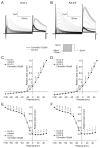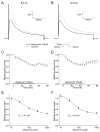Differential Effects of the Betablockers Carvedilol, Metoprolol and Bisoprolol on Cardiac Kv4.3 (Ito) Channel Isoforms
- PMID: 37762145
- PMCID: PMC10530285
- DOI: 10.3390/ijms241813842
Differential Effects of the Betablockers Carvedilol, Metoprolol and Bisoprolol on Cardiac Kv4.3 (Ito) Channel Isoforms
Abstract
Cardiac Kv4.3 channels contribute to the transient outward K+ current, Ito, during early repolarization of the cardiac action potential. Two different isoforms of Kv4.3 are present in the human ventricle and exhibit differential remodeling in heart failure (HF). Cardioselective betablockers are a cornerstone of HF with reduced ejection fraction therapy as well as ventricular arrhythmia treatment. In this study we examined pharmacological effects of betablockers on both Kv4.3 isoforms to explore their potential for isoform-specific therapy. Kv4.3 isoforms were expressed in Xenopus laevis oocytes and incubated with the respective betablockers. Dose-dependency and biophysical characteristics were examined. HEK 293T-cells were transfected with the two Kv4.3 isoforms and analyzed with Western blots. Carvedilol (100 µM) blocked Kv4.3 L by 77 ± 2% and Kv4.3 S by 67 ± 6%, respectively. Metoprolol (100 µM) was less effective with inhibition of 37 ± 3% (Kv4.3 L) and 35 ± 4% (Kv4.3 S). Bisoprolol showed no inhibitory effect. Current reduction was not caused by changes in Kv4.3 protein expression. Carvedilol inhibited Kv4.3 channels at physiologically relevant concentrations, affecting both isoforms. Metoprolol showed a weaker blocking effect and bisoprolol did not exert an effect on Kv4.3. Blockade of repolarizing Kv4.3 channels by carvedilol and metoprolol extend their pharmacological mechanism of action, potentially contributing beneficial antiarrhythmic effects in normal and failing hearts.
Keywords: Ito; Kv4.3; antiarrhythmic effects; betablocker; heart failure.
Conflict of interest statement
The authors declare no conflict of interest.
Figures








Similar articles
-
Inhibition of cardiac Kv4.3 (Ito) channel isoforms by class I antiarrhythmic drugs lidocaine and mexiletine.Eur J Pharmacol. 2020 Aug 5;880:173159. doi: 10.1016/j.ejphar.2020.173159. Epub 2020 Apr 29. Eur J Pharmacol. 2020. PMID: 32360350
-
Differences between beta-blockers in patients with chronic heart failure and chronic obstructive pulmonary disease: a randomized crossover trial.J Am Coll Cardiol. 2010 Apr 27;55(17):1780-7. doi: 10.1016/j.jacc.2010.01.024. J Am Coll Cardiol. 2010. PMID: 20413026 Clinical Trial.
-
Bisoprolol compared with carvedilol and metoprolol succinate in the treatment of patients with chronic heart failure.Clin Res Cardiol. 2017 Sep;106(9):711-721. doi: 10.1007/s00392-017-1115-0. Epub 2017 Apr 22. Clin Res Cardiol. 2017. PMID: 28434020
-
Carvedilol versus other beta-blockers in heart failure.Expert Opin Investig Drugs. 2001 May;10(5):971-80. doi: 10.1517/13543784.10.5.971. Expert Opin Investig Drugs. 2001. PMID: 11322870 Review.
-
[Beta-adrenolytics in heart failure--are they all really equal?].Przegl Lek. 2005;62 Suppl 2:39-42. Przegl Lek. 2005. PMID: 16623117 Review. Polish.
References
-
- Giudicessi J.R., Ye D., Tester D.J., Crotti L., Mugione A., Nesterenko V.V., Albertson R.M., Antzelevitch C., Schwartz P.J., Ackerman M.J. Transient outward current (I(to)) gain-of-function mutations in the KCND3-encoded Kv4.3 potassium channel and Brugada syndrome. Heart Rhythm. 2011;8:1024–1032. doi: 10.1016/j.hrthm.2011.02.021. - DOI - PMC - PubMed
-
- Olesen M.S., Refsgaard L., Holst A.G., Larsen A.P., Grubb S., Haunso S., Svendsen J.H., Olesen S.P., Schmitt N., Calloe K. A novel KCND3 gain-of-function mutation associated with early-onset of persistent lone atrial fibrillation. Cardiovasc. Res. 2013;98:488–495. doi: 10.1093/cvr/cvt028. - DOI - PubMed
-
- Radicke S., Cotella D., Graf E.M., Banse U., Jost N., Varro A., Tseng G.N., Ravens U., Wettwer E. Functional modulation of the transient outward current Ito by KCNE beta-subunits and regional distribution in human non-failing and failing hearts. Cardiovasc. Res. 2006;71:695–703. doi: 10.1016/j.cardiores.2006.06.017. - DOI - PubMed
MeSH terms
Substances
Grants and funding
LinkOut - more resources
Full Text Sources
Medical
Research Materials
Miscellaneous

